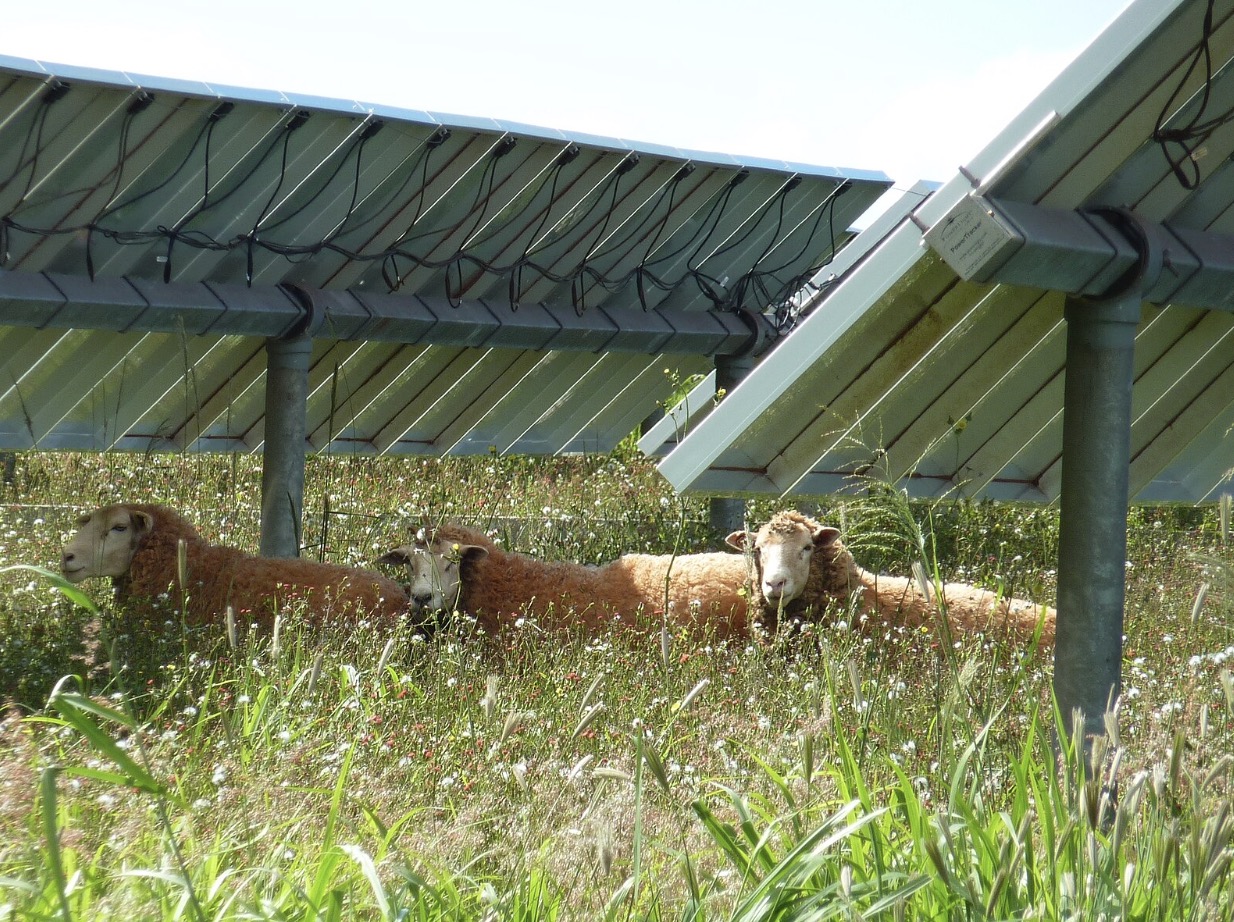News : Farming + Solar = Agrivoltaics
Agrivoltaics (noun): agricultural production, such as crop or livestock production or pollinator habitats, underneath solar panels or adjacent to solar panels
One of the biggest concerns I hear from rural folks about large solar panel installations is taking away “prime agricultural land.” Even with projects with strong community support, supporters feel the need to address the issue.
In a recent hearing on the proposed Flickertail Solar project, to be built 30 miles south of Fargo, landowners repeatedly stressed the point that most of the land being used by the project was bad, salt-poisoned, and unproductive. That these farmers felt the need to justify their own voluntary actions on their land points to something deeper than merely money – this is a conversation about values and the things we choose to prioritize in our communities. In rural, farming-oriented areas, farming is a moral virtue itself.
Here’s the good news: Utility-scale solar and agriculture can exist on the same land – and even benefit each other.
Solar facilities pay land rental costs high enough to offset the farming value of the land for the next 30-45 years. Once the solar is installed, the developer must also maintain it, otherwise, vegetation will overtake the array. Cutting vegetation can cost as much as hundreds of dollars per acre per year, making it a major long-term operating expense. Animal agriculture is starting to take over this role. Sheep, goats, and even cattle can do this role for free – turning an expense into a revenue stream. Sheep present the optimal case, generating multiple revenue streams while also being a moderately sized and docile animal.

Sheep at the La Ola Solar Farm on Lanai Hawaii keep weeds and grass trimmed down under solar panels.
Animal agriculture is only the start. Studies into collocating intensive, perennial agriculture like blueberries (University of Maine) and cranberries (UMass) are ongoing. Innovations like vertical ‘fence’- style solar installation may allow mechanized commodity agriculture to be viable alongside energy generation. Dynamic permaculture systems may turn out to be an ideal partner.
Agrivoltaics can go further, into land restoration. Solar panels can provide much-needed shade, reducing evaporation. The layouts of many utility-scale projects come with the paddocks of a regenerative grazing system prebuilt. Solar is completely compatible with natural water harvesting and retention systems and can be used in conjunction with habitat restoration for migrating birds and insects.
Research and experimentation into this field are only starting, and it needs more direct research funding. Without a strong grasp of the agronomics or well-developed logistics for these crops or livestock to be marketable, developers will continue to stick with the tried and tested solutions: Mowing, gravel, and concrete.
New firms like Silicon Ranch hope to bridge these gaps, but firms like these will not bring the benefits to the community that will be needed to sway local farmers, who don’t want to compete against deep-pocketed Silicon Valley investors. Much like the Bold Alliance’s other strategies – neighbor dividends and community benefit agreements – the best practice here is for these operations to be owned by the communities and the workers themselves. Importantly, this offers an opportunity to build new community benefits into solar facilities that are already constructed.
Instead of competing with local farmers, these community-controlled operations can serve as hubs for local diversification into smaller niche outputs. A farmer can have a few acres that aren’t good for much, but an area that small isn’t enough to support enough sheep to be viable. A community-owned operation can provide that scale, and market the outputs from these sheep (or bees, goats, llamas, etc) on behalf of their community members.
These operations can be federated, giving them the financial and market power to keep them viable and to make strategic investments in downstream processing, potentially bringing much-needed jobs and economic development to small towns. A set of operations utilizing just sheep and bees could support processing operations for lamb, wool, and honey. It isn’t hard to imagine such an operation expanding the lands it operates on to further diversify its operations. Taking over management of windbreaks, used to prevent soil loss in susceptible areas, would be one such possibility. Parks, public lands, water retention ponds, and many other possibilities exist.

A representative comment from a local Facebook post on a proposed solar array.
What do farmers and other rural folks think of this? Well, they often come up with the core idea on their own.
In recent meetings with the local townsfolk in Abercrombie, North Dakota, both community benefit agreements and land management were topics of discussion, and the usage of the land generated as much conversation as a potential $100k+ community benefit agreement. This option is a revelation to skeptical locals, opening minds to what could be.
The opportunity to lead on this issue, develop these community-centric operations, federate them, and expand rests before us. Will we take the opportunity to lead?
